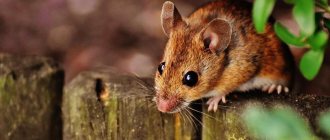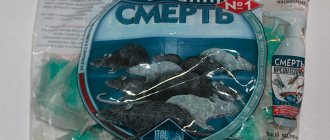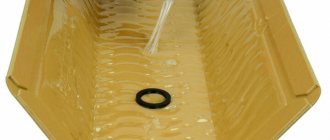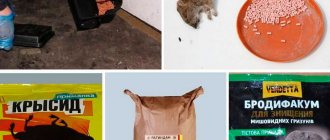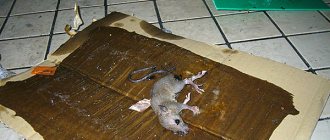At the beginning of winter, with the first frosts, mice, driven by hunger and cold, begin to invade human habitation. Mice in the house are always a huge headache for owners. They not only spread dangerous infections and announce their presence with a peculiar mouse odor, but also damage building structures, communications, and furniture. In this article we will look at:
- Why do mice try to get into the house?
- Mice in a private house: what wall material do rodents prefer?
- What to do to prevent mice from entering your home?
- How to get rid of mice in the house.
Mice in a private house
Hunger and cold drive mice into human homes. In summer, rodents can feed in fields and vegetable gardens, and with the onset of frost they run to where there are food reserves.
Mice have an excellent sense of smell; they can sense food at a distance of two kilometers.
A bag of flour in the pantry, bags of cereal in the kitchen cabinet... All this is like a magnet for mice.
And if the house is not protected from rodents at the construction stage, nothing and no one can stop the mouse that is trying to get into the house.
In addition to the smell of food, human housing attracts mice due to heat leaks.
The better the house is insulated, the better the heat is contained and the less it leaks out, the less it attracts rodents.
There is such a recommendation: with the onset of winter, it is good to heat the house and check it with a thermal imager. Places of heat leaks will usually be entry points for mice into the house. It is important to fix leaks as quickly as possible.
Typically, several large family mouse colonies (a male, several females and cubs) live in one private house. In a heated house with artificial lighting, mice cease to keep themselves within the boundaries determined by nature: they breed all year round (and not just in summer), they can be active at any time of the day (and not just at night), etc.
Over the course of a year, a female house mouse produces on average about 10 litters of 3-12 cubs each.
And all this horde of mice is constantly gnawing on something. Mice cannot do otherwise: the incisors of these rodents grow throughout their lives, and they must constantly grind them down so as not to die.
Mice in the house gnaw through plastic pipes and wiring, get into household appliances and cause short circuits, damage walls, floors, furniture...
Causes of rodents
Various types of rodents, just like insects, can settle next to a person and cause him a whole lot of inconvenience.
Before you begin to destroy such unwanted neighbors, you must first find out the possible reasons for their appearance in order to avoid relapses in the future.
Most often, their appearance is accompanied by the following factors:
- The presence of food and various edible supplies that are stored in places that are accessible to mice. It is worth noting that storing food in bags and even hanging cabinets is not considered a sufficient degree of protection, since such obstacles are not insurmountable for rodents.
- Violation of sanitary standards in the premises, which can be expressed in rare garbage removal, leading to its accumulation in large volumes, as well as extremely rare cleaning. All these factors create a favorable environment for rodents to live in, since among the waste there is almost always food suitable for them.
- Favorable temperature conditions, this factor becomes most relevant with the onset of winter cold, when mice are ready to sacrifice their own safety for the sake of moving to warmer places, including human homes.
- Mass migration of rodents, which can begin due to the fact that someone nearby began to purposefully poison and exterminate them.
Why are mice dangerous in the house?
Mice in the house are carriers of pathogens of many parasites and dangerous diseases.
Here are just some of the diseases that mice can infect humans:
- toxoplasmosis,
- salmonellosis,
- leptospirosis,
- tularemia,
- bartonellosis,
- hantavirus infection.
- different types of fevers.
Fleas and ticks can live on mice, which quickly spread to pets and people. Mice also carry eggs of different types of helmites.
Poison - the best drugs
The poison has a good effect and copes well with rodents. Manufacturers produce it in the form of powder, special liquid, poisonous briquette, paste. The following brands have proven themselves well:
- "Rat Death No. 1." The poisonous mass has a pleasant aroma that rodents like. It releases fumes that are harmful to rats and have a depressing effect on the respiratory system of the pests. The maximum effect is achieved a week after treatment;
- "Goliath". The drug helps to poison a large number of rodents. Its effect does not begin immediately, but after a week. During this time, all pests eat the bait, which does not cause them any concern. Soon all the animals die;
- "Ratid 1". Helps poison rodents, used in all types of buildings;
- "Storm". The main advantage of the poison is the lack of decomposition of dead individuals. In this regard, there is no specific smell;
- "Nutcracker". The green briquette acts as bait. The rodent absorbs a poisonous mass that poisons the circulatory and respiratory systems. After a short period of time, suffocation develops, which forces the rodent to crawl out into open areas. A dead specimen is easy to locate and dispose of;
- "Tsunami". The tablet preparation is pink. Safe for pets and people. It has a cumulative effect, having a detrimental effect on the cardiac, nervous and circulatory systems of the rodent.
A poisoned mouse should not be handled with bare hands. You can throw out the pest using a dustpan, or wearing household gloves on your hands.
How mice get into the house
Mice enter homes in a variety of ways. Here are the most common:
- Through passages in the ground . Mice dig under the foundation lining and end up under the floor, from where they climb into the house through cracks or gnaw holes in the floor, in corners, etc.
- Through the wind holes . The mice perceive vents unprotected by bars in the foundations as hospitably open doors. Mice can live in ventilation ducts, penetrating through them into the structure of walls, ceilings, etc.
- Through building materials . Mice, not as rarely as we would like, settle in large foam and aerated concrete blocks, ready-made frame structures insulated with foam plastic, etc. These cunning rodents can hide in a building element and wait until the installation of the structure is completed.
The location of the house in the mouse issue is more important than the material of the walls: if the building is located not far from the field, then in the fall dozens of mice will be attracted to it.
But if you protect the house (and better at the construction stage), close all the cracks, cover the holes with bars, make the floor structure insurmountable for rodents, then they, realizing the futility of their attempts, can forever forget the way to this building.
Physical methods
There are many types of mousetraps, traps and traps for mice. The difference lies in the mechanism of action and the principle of catching rodents. Compact devices are easily installed in mouse habitats, where they often pass in search of food. The most popular types of physical mouse traps are those presented below.
Classic mousetraps
The advantage of classic mousetraps is the possibility of repeated use immediately after the caught animal is removed. To do this, install a new bait and cock the return spring. You don’t have to do anything else; replacement of parts and consumables is not provided here.
Trap
This refers to a metal cage with a raised door. The bait lies in the far corner and presses the thread that holds the locking mechanism. The principle of operation of the device is that the animal enters the cage, heading towards the bait, releases the thread, thereby closing the door, the mouse remains inside.
Another type of mouse trap is a small box with an entrance that only works in one direction. Having caught the aroma of bait, the rodent gets inside, but is no longer able to get out.
Electrical accessories
An electric mouse trap can be powered by AA batteries or from an outlet. The device is built on the principle of placing bait inside an energized zone. The mouse sees a tasty morsel and moves towards it, stepping on the wires and receiving an electric shock, the value of which is sufficient to cause its death.
Electric traps are quite popular and differ in size and the presence of additional options, for example, it can be a chamber for storing corpses, sound or light indicators of capture.
Important! The devices operate on electricity. When the batteries are disconnected or low, they turn off.
Glue trap
An equally effective way to control rodents. Presented in the form of a regular plate treated with a sticky non-toxic composition. The mice become glued to the base, unable to free themselves.
Important! When using such devices, you need to be prepared to peel the caught mouse off the base while it is still alive. As an alternative, many people throw away the stickers along with the caught animal.
How to make an expanded clay mouse lock
Expanded clay lock prevents rodents from entering the house through the floor. With this method, expanded clay is included in the floor cake. Here is the floor pie (from the ground):
- layer of expanded clay (30 cm or more),
- polyethylene film;
- two layers of OSB-3;
- expanded clay;
- OSB impregnated with boric acid and synthetic wax.
Expanded clay will become a mechanical obstacle for mice, and boric acid will act as an additional chemical repeller until it wears off.
Another way to protect your floor is to cover all cracks with galvanized steel strips. In this case, the floorboards are laid directly along the joists, without insulation, the cracks are covered with wide (about 10 cm) strips, they are nailed to the floor, and the top is covered with insulation and sheathing.
Where to start removing rodents
In the process of breeding or destroying mice, you can encounter a number of difficulties, since they will not be in any hurry to give up their acquired places to a person. For this reason, before embarking on full-scale actions, it is necessary to first change the living conditions of unwanted neighbors, making them less favorable.
First of all, this process includes the following set of measures:
- Review all conditions related to the storage of edible supplies. Food should be stored in the refrigerator or any place inaccessible to rodents; cereals, nuts and seeds should be stored exclusively in glass jars; At night, nothing edible should be left on the table.
- Carrying out extensive cleaning throughout the house will subsequently need to be repeated regularly , with special attention, while paying attention to the kitchen area.
- Eliminate all holes and large cracks in the surface of the walls and floor , since these are the areas that mice most often use for housing and storing stolen food supplies.
- Use means that will create unpleasant conditions for them , for example, scatter ash or maintain a constant aroma of elderberry in places where they often gather or live.
How to get rid of mice in the house forever: metal mesh
Biologists say that a mouse will fit even into a hole that would be impossible to insert a pencil into. This is true. The mouse has a very flexible skeleton, and its skull “folds” like that of a baby during childbirth. Therefore, a galvanized mesh to protect against mice must consist of the smallest cells. The second requirement is that it must be made of very durable metal.
The mesh should be made of wire thicker than 2 mm, the cell dimensions should be no larger than 10x10 mm.
The mesh is laid on the subfloor.
They're wrapping her foundation
Or they close the ventilation holes.
All corners are covered with fine mesh (as reinforcement for plaster). It is important not to miss a single corner, not a single joint.
The ventilation gap between the insulation and the sheathing below is also covered with this mesh: you should get a box with walls at least 5 cm high.
Also, a fine-mesh mesh is buried in the ground along the perimeter of the foundation to a depth of 80 cm so that mice cannot dig under it.
To protect against mice, the base is lined with fine-mesh mesh at least a meter in height.
Professionals advise laying fine mesh wherever a mouse could theoretically sneak through.
For additional protection of the base, it is recommended to sheathe it to a height of at least a meter:
- corrugated sheet made of structural steel 1.5 mm thick (in waves lengthwise);
- slippery smooth plastic;
- plaster (but to prevent the mouse from chewing through the plaster, the top is finished with acrylic putty and slippery paint is applied to the putty).
Types of bait
The standard idea, drawn from a popular cartoon, is that mice are ready to fight to the last drop of blood for a piece of cheese.
In fact, this concept is completely wrong. Rodents react much faster to natural and familiar food, such as grain, bread and some smells. To effectively lure mice, it is better to use a fresh piece of aromatic bread , which is additionally moistened with aromatic unrefined sunflower oil. It must be said that using sesame oil instead gives a greater luring effect. Sesame does not grow in our country, but its smell is so attractive to mice that just a drop of oil from this plant will attract a large number of rodents.
How to get rid of mice in the house
It is very difficult to get rid of mice in your home forever.
- Various repellers emit such signals that the owners want to escape from the house along with the mice.
- Poisoned baits will mean that there will be mouse remains lying somewhere in a secluded corner.
- Mice easily get caught in mousetraps, even homemade ones: catching a mouse with a plastic bottle works great. To do this, you need to pour a little oil into the bottle (preferably the kind you used to fry fish or sunflower seeds). The same oil should be used to thoroughly coat the neck of the bottle from the inside and strengthen it at an angle of 45 degrees. The mouse will become a victim of its legendary sense of smell - it will definitely climb into the bottle, but will not be able to get back out.
- A good cat can also help. If a real seasoned mouse catcher settles in the house, the mice will most likely leave the room.
Damage to people and homes
The damage that rodents cause in a person’s home is so significant that it is difficult to even imagine. These animals can chew wires, which can cause a fire, and damage soft toys and upholstered furniture, as well as other items. In addition, mice are carriers of dangerous diseases such as salmonella, plague, typhus, and Weil's disease. Infection can occur through food on which a mouse has run and left traces of its activity. Rodents are distinguished by the fact that they leave their excrement everywhere, infected with various viruses and bacteria. Even waste vapors pose a danger. Children and the elderly who have weakened immune systems may be the first to suffer.
Despite their small size, the damage these pests cause is quite significant. Even in ancient Rome, mice were caught with various mousetraps. Pests are also distinguished by the fact that they quickly adapt to new conditions. They survive in conditions of extreme cold, hunger and even high humidity. They build warm nests for themselves and store food for future use, and having sharp eyesight helps them avoid danger in time. In search of food they move over considerable distances.
Summarizing
Fighting mice is a difficult and nerve-wracking business. It is much better to protect your home from their entry by choosing the right building materials and using chicken wire to protect the foundation and vents.
FORUMHOUSE has an excellent collection of ways to protect facades, ceilings and foundations of houses from mice. Find out how to protect your garden and vegetable garden from mice. Read our articles about humane methods of controlling moles and other garden pests: mole crickets, pests that attack wood. Watch our video on how to save a tree that has been chewed by mice.
Subscribe to our Telegram channel Exclusive posts every week
Mechanical traps (mousetraps)
The list of structures that are used to combat unwanted neighbors is very long. Devices for catching pests are constantly being improved and modified. Mousetrap with frame
This is a long-known structure with a base made of wood, metal or plastic, to which a metal frame and spring are attached. When the mouse grabs the bait, the mechanism is triggered and the frame kills the rodent.
Minuses:
- False alarm, jamming.
- Mice learn to deceive the structure and drag the bait with impunity.
- Low degree of effectiveness with large numbers of mice.
The disadvantages of a mousetrap include the fact that after the mousetrap has fulfilled its intended purpose, the caught rodent must be removed, after which the device can be reused.
Mouse trap
